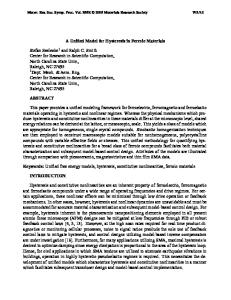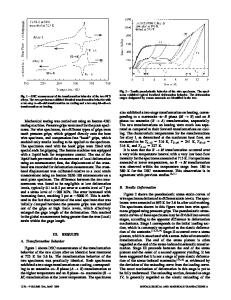A Stress-Dependent Hysteresis Model for PZT
- PDF / 279,541 Bytes
- 11 Pages / 612 x 792 pts (letter) Page_size
- 30 Downloads / 298 Views
CC1.8.1
A Stress-Dependent Hysteresis Model for PZT Brian L. Ball1 , Ralph C. Smith1 , Sang-Joo Kim2 , and Stefan Seelecke3 1
Center for Research in Scientific Computation, Department of Mathematics, North Carolina State University, Raleigh, NC 27695, [email protected], [email protected] 2 Mechanical and Information Engineering, University of Seoul, 130-743 Korea, [email protected] 3 Mechanical and Aerospace Engineering, North Carolina State University, Raleigh, NC 27695, stefan [email protected] ABSTRACT This paper addresses the development of an energy-based characterization framework which quantifies stress-induced dipole switching in ferroelectric materials. Helmholtz and Gibbs energy relations that accommodate 90o and 180o dipole orientations as equilibrium states are constructed at the lattice level. For regimes in which thermal relaxation mechanisms are negligible, minimization of the Gibbs relations provides local polarization and strain relations. Alternatively, behavior such as creep or thermal relaxation can be incorporated by balancing Gibbs and relative thermal energies through Boltzmann principles. In the final step of the development, stochastic homogenization techniques based on the assumption that parameters such as coercive and induced fields are manifestations of underlying distributions are employed to construct macroscopic models suitable for nonhomogeneous polycrystalline compounds. Attributes and limitations of the model are illustrated through comparison with experimental PLZT data. INTRODUCTION The quantification of stress-induced dipole switching mechanisms in ferroelectric materials is of fundamental importance for both material characterization and design of transducers which employ these compounds. Whereas a number of mechanisms contribute to the ferroelastic behavior exhibited by these compounds, the interplay between 90o and 180o dipole switching is of primary importance. In this paper, we summarize a multiscale characterization framework that quantifies this hysteretic and nonlinear, stress-induced behavior in a manner which is sufficiently efficient for subsequent transducer and model-based control design. The framework is developed and illustrated in the context of PZT but is sufficiently general to encompass a variety of ferroelectric materials. In the first step of the development, Helmholtz and Gibbs energy relations are constructed at the lattice level to quantify the internal and electrostatic energy associated with 90◦ and 180◦ dipole orientations. For regimes in which thermal activation is significant, the Gibbs and relative thermal energies are balanced through Boltzmann theory to provide equilibrium relations quantifying local strains and polarizations as a function of input stresses and fields. In the limit of negligible thermal activation, the local relations reduce to minima of the Gibbs energy and enforcement of these minimization criteria significantly improves the efficiency of the model and inversion process employed for linear control design. Parameters such as
Data Loading...











